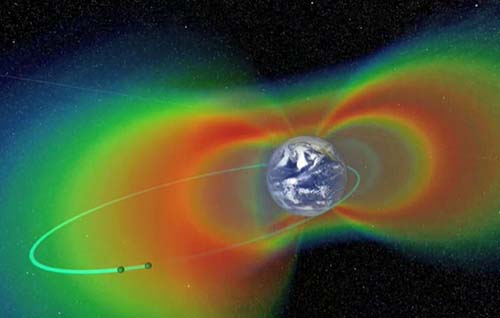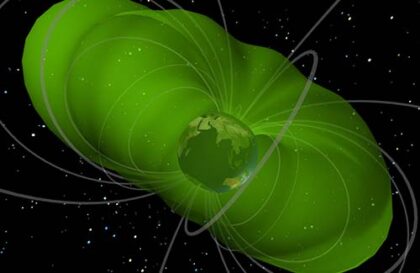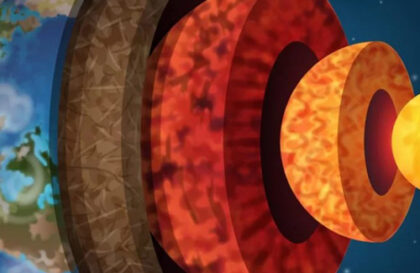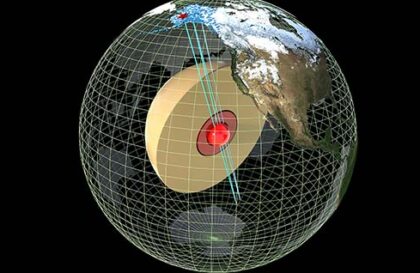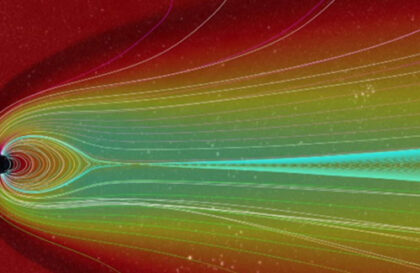Above the Earth’s ozone layer, which protects us from ultraviolet radiation. These are the Van Allen radiation belts. They protect the Earth from the fastest and most energetic electrons coming from space.
If not for the ozone layer around our planet, our surface would likely be similar to the harsh and lifeless landscape we see on Mars.
Van Allen belts
Since the beginning of the 20th century, scientists have been studying the existence of radiation belts around the Earth. Still, confirmation of this was received only in 1958 with the help of the Explorer 1 and Explorer 3 spacecraft. These belts were mapped in detail by subsequent missions such as Explorer 4, Pioneer 3, and Luna 1.
Van Allen radiation belts are regions filled with charged particles trapped in the Earth’s magnetosphere. The interaction of these belts with other magnetic fields was revealed in 2012 using specialized Van Allen probes. These belts can change in size in response to solar activity, sometimes growing to such an extent that they threaten satellites in low Earth orbit.
Two spacecraft have been launched directly into swaths of radiation where most fear to fly. Credit: NASA’s Goddard Space Flight Center
Scientists must understand the causes and mechanisms of such changes in radiation belts. This not only expands our knowledge of Earth and space but also allows us to predict potential threats to satellites and spacecraft and develop radiation protection measures.
What do Van Allen belts protect against?
If high-energy electrons penetrate the Earth’s magnetic field and atmosphere to the surface, they can interact with DNA molecules, causing them to break down or mutate. This can lead to cancer or other genetic abnormalities. In addition, radiation can damage other biomolecules, leading to various biochemical disturbances in the cell.
If large numbers of electrons enter the body, they can cause tissue heating. Although this effect may be less significant than radiation damage, it can still lead to heat stress.
Some research suggests that radiation can affect nerve cells and lead to neurological damage, although the mechanisms of this effect are not yet fully understood.
Electrons can also damage or even destroy electronic devices, including medical equipment.
What did scientists find out?
Over the years of research, it has been found that the Van Allen radiation belts can change their shape. There are two belts, but sometimes they can merge or split into three. Typically, the inner belt ranges from 644 to 10,000 km (400–6,000 mi) above Earth, while the outer belt extends from 13,500 to 58,000 km (8,400–36,000 mi).
A question that has long interested scientists is the reason for a separate space between these two belts. Recent studies using Van Allen Probes have shown a clear boundary in the outer belt that even high-energy particles cannot overcome.
It was initially thought that this barrier could have been created by artificial transmissions or the shape of the Earth’s magnetic field. However, these studies refuted these hypotheses, pointing to other cosmic particles as the most likely reason for the existence of this boundary.
New Earth defense structure discovered
Credit: NASA/Goddard Space Flight Center Scientific Visualization Studio
Next to the radiation belts near Earth is another structure known as the plasmasphere. This cloud of cold, charged particles begins at an altitude of about 1,000 km (600 miles) and extends into the radiation belts. The plasmasphere affects particles of the radiation belt, causing them to scatter and be removed from the belt.
The electrons in the radiation belt move quickly, but their trajectory is not directed toward the Earth. They move around the planet, forming giant loops. The most energetic of these electrons move toward Earth slowly, allowing them to be scattered effectively by the plasmasphere. Based on data from the Van Allen probes, it became known that this scattering process is sufficient to control the approach of electrons to the Earth and influence their distribution in the radiation belts.
Solar activity, such as solar solid winds or coronal mass ejections, can significantly impact near-Earth space. Under extreme conditions, these phenomena can cause electrons to move from the outer radiation belt into the ordinarily empty region between the two belts.
Under normal conditions, the scattering of particles at the boundary of the plasmasphere called the plasmapause, creates a barrier to particles in the radiation belts. This barrier acts like a wall, preventing electrons from moving inward toward the Earth. However, during solar solid wind or other solar activity phenomena, the boundary of the plasmasphere can shift closer to the Earth.
When this happens, the outer part of the plasmasphere can be destroyed or compressed, causing its boundary to move. This, in turn, allows electrons from the radiation belts to move deeper into near-Earth space, disrupting the normal distribution of electrons between the two belts.
The Universe has done an excellent job of protecting life on Earth.
Banner image: NASA/Goddard Space Flight Center Scientific Visualization Studio
Image credit:
https://svs.gsfc.nasa.gov
https://svs.gsfc.nasa.gov
https://svs.gsfc.nasa.gov
